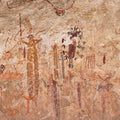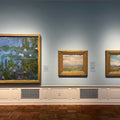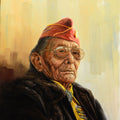Washoe Baskets Highlighted at Two Nevada Museums
By Chadd Scott on
Indigenous art supplies often come from the earth, not a store. Native American baskets are produced from grasses and shrubs and tree bark. Native American pottery literally originates from the earth, the ground. From clay.
The Nevada Museum of Art explores the inseparable connection between maker and material with “Of the Earth,” highlighting how art, cultural legacy, and environmental awareness converge in the production of Native American baskets and Pueblo pottery. The presentation marks the inaugural exhibition in a gallery space newly opened in March 2025.
Also debuting are two transformative gifts to the museum’s permanent collection.
The first is an expansive collection of Native American baskets from Larry Dalrymple and Steve Moreno who spent more than 45 years collecting works and personal histories from contemporary weavers across the Great Basin, Northern California, and the American Southwest.
“Not only did Dalrymple negotiate the purchase of each basket with the weaver directly, he also asked the weaver if he could write down their biography and take their portrait,” Ann M. Wolfe, the museum’s Chief Curator and Associate Director and exhibition co-curator, said. “The Nevada Museum of Art does not own or collect historical Native baskets whose history and circumstances of production can be problematic, nor does the museum collect any baskets without clear provenance.”

Norma Darrough, Western Shoshone, ‘My Sunburnt Willow Water Jug,’ 2024-25. Twined; split willow, sunburnt willow, redbud, leather strap, 16 x 9 inches. Collection of the Nevada Museum of Art.
The baskets in “Of the Earth” are all made from 1970 to the present.
Visitors to the basket gallery will encounter a beautiful presentation of hundreds of baskets housed in brand new display cabinetry. Visitors can use digital information kiosks to learn more about each individual basket, the maker of the basket, and the story of the basket. An interpretive film was also produced that is on view with numerous weavers speaking about their own practice.
To honor the living traditions of Native American basketweaving, “Of The Earth” also features newly commissioned baskets by Native American weavers from the Great Basin and Sierra Nevada
The second gift came via the John and Brenda Blom Southwest Pottery Collection, comprising hundreds of examples of Pueblo pottery acquired directly from artists and villages across the American Southwest beginning in the early 1990s.
Those dates are significant. These are presentations of contemporary Native baskets and pottery, reinforcing how those timeless traditions – and the people who make them – carry forward through today and into the future.
“Basketweaving and pottery making are alive and well in the American West and this exhibition makes that abundantly clear,” Wolfe said.
This exhibition aligns with the museum’s Indigenous Art Futures initiative, a commitment to exploring the complex relationships between Indigenous art, land, and environments across the western United States. Through exhibitions, publications, and public programs, the museum aims to share these stories with statewide, regional, national, and global audiences.
One such publication is “The Art of Native American Washoe Basketry” released this past March. The Washoe people have lived in the Lake Tahoe region of California and Nevada for millennia. Wolfe co-authored the book.
The Nevada Museum of Art has a long history of collaboration with the Washoe Tribe of Nevada and California. The museum worked with the Tribe’s cultural committee to share the story of Washoe baskets in the book. The two also worked together on incorporating JoAnn Nevers’s (1936–2020) voice and story into the publication. She was a writer, historian, and Elder of the Washoe Tribe of Nevada and California.

Display case of Native American baskets as part of 'Of the Earth' exhibition at Nevada Museum of Art. Photo courtesy of the museum.
“Of the Earth”
The newly commissioned baskets showcased alongside contemporary baskets and Pueblo pottery highlight how the stories of Indigenous communities are shaped by – and respond to – the land.
“Each basket and every piece of pottery embodies the intimate relationship between natural resources – land, water, plants and clay – and reveals deep respect for community, tradition, and place,” Wolfe explained.
That may seem obvious, or maybe it doesn’t.
Why do basket makers weave baskets while potters make pottery? The answer is the land. Access to materials. Visit the Pueblos across New Mexico and you won’t find the volume of plants suitable for basketmaking. You will find plenty of earth. Soil. Clay. Perfect for pottery.
And vice versa.
With plentiful access to materials above ground from which to make baskets, there was no reason for basket makers to try firing their rich earth into pottery.
“Basket weaving is not just a craft, but a practice that fosters relationships with the natural world and with ancestors,” Wolfe said. “Many weavers see their baskets as their relations. They carry stories as well as knowledge passed down through generations.”
The same can be said of Pueblo pottery.
Any real understanding and appreciation of the baskets and the pots develops from acknowledging how they represent more than simple – if ingenious – vessels.
“The practice of weaving is rooted in a deep understanding and stewardship of plants and the environment,” Wolfe said. “Weavers nurture plants throughout the year: they visit them, they prune them, and they harvest them to assure the plant will produce material for the following season. There are many things that threaten the availability and suitability of plants used for baskets. As a weaver said to me once, ‘You ask the plant if you can harvest, because that plant is giving its life.’”
Museum guests can experience a microcosm of this relationship on the new rooftop Great Basin Native American Basket demonstration garden. There, over 40 plant varieties directly tied to the making of baskets on view in the galleries grow. The garden was developed with weavers from the region.
“Under One Sky”
Thirty miles south of Reno and the Nevada Museum of Art, the Nevada State Museum in Carson City, likewise, highlights Washoe basketweaving in a newly opened gallery. Developed in close collaboration with the Washoe Tribe, the Under One Sky Basketry Gallery brings together the iconic work of famed weaver Louisa Keyser, known as Datsolalee, and other talented Washoe artists who will have work on display at the museum for the first time in nearly two decades.
The Nevada State Museum’s new basketry gallery opened in May of 2025.



